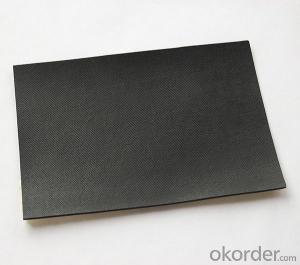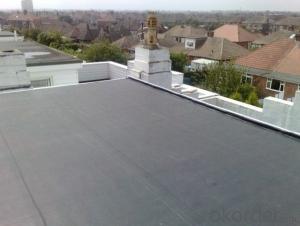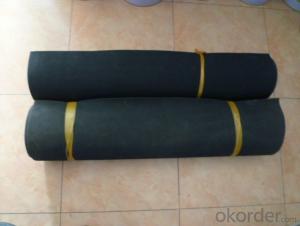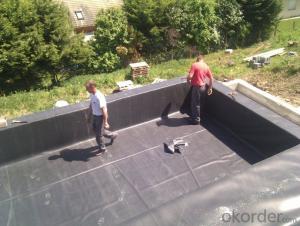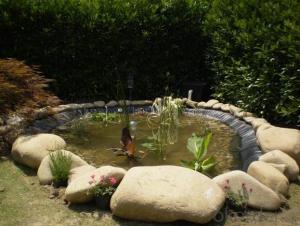EPDM Coiled Rubber Waterproof Membrane for Artificial Pond Landscape
- Loading Port:
- Shanghai
- Payment Terms:
- TT OR LC
- Min Order Qty:
- 50000 m²
- Supply Capability:
- 5000000 m²/month
OKorder Service Pledge
OKorder Financial Service
You Might Also Like
EPDM Coiled Rubber Waterproof Membrane for Artificial Pond Landscape
Description Of EPDM Coiled Rubber Waterproof Membrane for Artificial Pond Landscape:
•EPDM waterproof sheet has excellent anti-ozone-aging performance, able to resist ultraviolet light and corrosion of many chemical corrosive materials in the atmosphere
•It has high tensile strength, high ductility and strong retractility, it has excellent crack resistance, able to effect waterproof function even with tiny vibration of buildings.
• Excellent resistance to ozone, oxidation and sunlight.
• Resistance to chemicals; resistant to most inorganic products.
Main Features of EPDM Coiled Rubber Waterproof Membrane for Artificial Pond Landscape:
A.Polyester based SBS Modified Bitumen Waterproofing Membrane
a. Strong impermeability
b. High tensile strength, elongation, ability to adapt the grassroots shrinkage deformation and cracking
c. Puncture-resistant, broken resistant, tear-resistant
d. The corrosion resistance, resistance to mildew, weathering good
e. Construction convenient, hot-melt can be operated Four Seasons Construction, reliable joints
Specifications of EPDM Coiled Rubber Waterproof Membrane for Artificial Pond Landscape:
| Material | EPDM Rubber |
| Size | 1.2m (width)*20m (length) or customized, weldable type 2.05m or 4m width |
| Thick | 1.2mm, 1.5mm, 2.0mm |
| Type | Vulcanized & Weldable |
| Pattern | Non-reinforced (homogeneous) |
| Certificate | ISO9001/14001 |
Applications of EPDM Coiled Rubber Waterproof Membrane for Artificial Pond Landscape:
1. The substratum should be smooth, dry, clean, which can not have loosing and peeling phenomena.
2. Before application, clean up the basic level and eradicate the impurities.
3. Spread out the membrane on the substratum to loose sheet's stress. Use adhesive-glue to paint the substratum and the surface of membrane. When the adhesive is not sticky to hands, pave and press smoothly.
4. When pave the second volume of membrane, extrude 100mm of the edge of overlap of the first roll and do not paint with the adhesive. Pave the membrane on the substratum according to step so as to finish the whole pavement. When paving, do not tighten the waterproof membrane violently.
5. After that, use the special solvent to scrub the overlap joint. When it becomes fully dry , use the sheet glue to paint the both sides of the joint. Paint it again when it gets completely dry. Till the adhesive is not sticky to hands, press it smoothly and solidly.
6. Pay attention to fire prevention during application. Basement construction site shall be equipped with ventilation facilities



IMages of EPDM Coiled Rubber Waterproof Membrane for Artificial Pond Landscape:




FAQ of EPDM Coiled Rubber Waterproof Membrane for Artificial Pond Landscape:
1. What are we supplying?
We are specialized in producing Colorful Asphalt Roof Shingle, SBS/APP modified bitumen waterproof membrane, Self adhesive bitumen waterproof membrane, PVC waterproofing membrane, EPDM rubber roofing membrane, Single Component Polyurethane Waterproof Coating, and Spray Polyurea Waterproof Coating
.
2. How Many years experience do we have?
We have been exported to more than 20 countries in the past 15 years.
3. How long do we usually reply your request?
We always reply our customer within 24 hours.
- Q:Can waterproofing membranes be installed on uneven surfaces?
- Yes, waterproofing membranes can be installed on uneven surfaces. In fact, one of the advantages of waterproofing membranes is their ability to conform to various irregularities and unevenness in the surface. These membranes are typically flexible and can be easily molded and adjusted to fit the contours of the substrate. Additionally, some waterproofing membranes have self-adhesive properties or can be applied with adhesives, allowing them to adhere to both smooth and uneven surfaces effectively. However, it is important to note that proper surface preparation is crucial for a successful installation. The surface should be clean, dry, and free from any loose materials or debris to ensure optimum adhesion and performance of the waterproofing membrane.
- Q:Can a waterproofing membrane be used on cinder block surfaces?
- Yes, a waterproofing membrane can be used on cinder block surfaces. Cinder blocks are porous materials that can absorb water, so applying a waterproofing membrane can help prevent moisture from penetrating the surface and causing damage. The membrane acts as a barrier, preventing water from infiltrating the cinder blocks and protecting them from moisture-related issues such as mold, mildew, and deterioration. It is important to properly prepare the cinder block surface before applying the membrane to ensure proper adhesion and effectiveness. Additionally, choosing a waterproofing membrane specifically designed for cinder block surfaces will provide the best results.
- Q:Can waterproofing membranes be used on concrete pools?
- Indeed, concrete pools can benefit from the utilization of waterproofing membranes. These membranes are purposely engineered to serve as a defense against water infiltration and can be administered on a multitude of surfaces, including concrete. Over time, concrete pools are prone to water seepage as a result of cracks or degradation. By applying a waterproofing membrane, the occurrence of such predicaments can be mitigated. Typically, the membrane is administered to the inner surface of the pool, thereby establishing a seamless and impervious seal. It is imperative to select a top-notch waterproofing membrane that is specifically formulated for swimming pool use to guarantee enduring and efficacious outcomes.
- Q:Can a waterproofing membrane prevent mold and mildew growth?
- Yes, a waterproofing membrane can help prevent mold and mildew growth. Mold and mildew thrive in damp and moist environments, and waterproofing membranes create a barrier that prevents water from seeping into the underlying surfaces. By keeping the area dry, the membrane reduces the conditions necessary for mold and mildew to grow. Additionally, some waterproofing membranes are designed with antimicrobial properties, which further inhibit the growth of mold and mildew. However, it is important to note that while a waterproofing membrane can help prevent mold and mildew growth, it is not a foolproof solution. Proper ventilation and maintenance are also crucial in preventing these issues.
- Q:Can a waterproofing membrane be used for bridges?
- Yes, a waterproofing membrane can be used for bridges. Bridges are exposed to harsh weather conditions and constant exposure to water, which can lead to deterioration and structural damage. Applying a waterproofing membrane to the bridge surface helps to protect it from water infiltration, preventing corrosion of reinforcing steel and extending the lifespan of the bridge. The membrane acts as a barrier, preventing water from seeping into the concrete and causing structural damage. It also helps to minimize the effect of freeze-thaw cycles, which can further damage the bridge. Additionally, the waterproofing membrane can improve the overall durability and performance of the bridge, reducing maintenance and repair costs in the long run.
- Q:Does a waterproofing membrane provide any soundproofing benefits?
- No, a waterproofing membrane does not provide any soundproofing benefits. A waterproofing membrane is specifically designed to protect surfaces from water penetration, such as roofs, walls, or foundations. It is typically made of materials like asphalt, rubber, or polyethylene, which are not effective in blocking or absorbing sound waves. Soundproofing, on the other hand, involves the use of special materials and techniques that can reduce or eliminate the transmission of sound from one area to another. This can include insulation, acoustic panels, or soundproof barriers. Therefore, if soundproofing is a concern, it is necessary to consider separate soundproofing measures in addition to a waterproofing membrane.
- Q:What is the resistance type SBS waterproofing membrane?
- The second is chemical resistance, in the waterproofing membrane production process, adding chemical resistance agent, similar to the chemical composition of herbicides, the plant roots are not close to the waterproofing membrane; In addition, copper ions have a similar effect.
- Q:Can a waterproofing membrane be used on both horizontal and vertical surfaces?
- Yes, a waterproofing membrane can be used on both horizontal and vertical surfaces. Waterproofing membranes are designed to create a barrier against water penetration, regardless of the surface orientation.
- Q:Does a waterproofing membrane require any specific cleaning or maintenance procedures?
- Yes, a waterproofing membrane does require specific cleaning and maintenance procedures to ensure its longevity and effectiveness. Regular cleaning and maintenance help to prevent the buildup of debris, dirt, and other contaminants that can compromise the membrane's ability to keep water out. The specific cleaning and maintenance procedures can vary depending on the type of waterproofing membrane used, but some general guidelines apply. Firstly, it is important to regularly inspect the membrane for any signs of damage, such as cracks, tears, or deterioration. If any issues are detected, they should be promptly repaired or replaced to prevent further damage. In terms of cleaning, it is recommended to remove any loose debris or dirt from the membrane surface using a soft-bristle broom or a leaf blower. Avoid using harsh chemicals or abrasive materials that can damage the membrane. Instead, use a mild detergent or specialized cleaning solution recommended by the manufacturer. Gently scrub the surface with a soft brush or sponge, and rinse thoroughly with clean water. Additionally, it is crucial to keep the surrounding drainage systems clear and free from any obstructions. Regularly inspect and clean gutters, downspouts, and drains to ensure proper water flow and prevent any potential water damage. Lastly, it is advisable to have the waterproofing membrane professionally inspected and maintained on a regular basis. This can help identify any potential issues early on and ensure that the membrane is functioning at its optimal level. Overall, by following these specific cleaning and maintenance procedures, you can prolong the lifespan of the waterproofing membrane and maintain its effectiveness in preventing water infiltration.
- Q:Are waterproofing membranes fire-resistant?
- The fire-resistant properties of waterproofing membranes can differ. Certain membranes are specifically engineered to be fire-resistant, whereas others may lack any fire resistance at all. To ascertain the fire-resistant capabilities of a particular waterproofing membrane, it is crucial to examine its specifications and certifications. Moreover, in specific applications, building codes and regulations might impose mandatory fire resistance requirements for waterproofing membranes.
1. Manufacturer Overview |
|
|---|---|
| Location | |
| Year Established | |
| Annual Output Value | |
| Main Markets | |
| Company Certifications | |
2. Manufacturer Certificates |
|
|---|---|
| a) Certification Name | |
| Range | |
| Reference | |
| Validity Period | |
3. Manufacturer Capability |
|
|---|---|
| a)Trade Capacity | |
| Nearest Port | |
| Export Percentage | |
| No.of Employees in Trade Department | |
| Language Spoken: | |
| b)Factory Information | |
| Factory Size: | |
| No. of Production Lines | |
| Contract Manufacturing | |
| Product Price Range | |
Send your message to us
EPDM Coiled Rubber Waterproof Membrane for Artificial Pond Landscape
- Loading Port:
- Shanghai
- Payment Terms:
- TT OR LC
- Min Order Qty:
- 50000 m²
- Supply Capability:
- 5000000 m²/month
OKorder Service Pledge
OKorder Financial Service
Similar products
New products
Hot products
Related keywords
